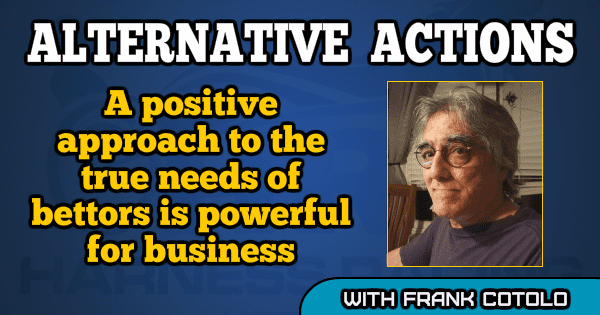

A positive approach to the true needs of a racetrack’s audience is powerful for business
by Frank Cotolo
What do people — any demographic — playing pari-mutuel racing — any breed — want? It is a question that is so simple it sounds imbecilic to ask. I would not be surprised however, if the greater percentage of racetrack managers answered incorrectly. As well, I bet that even if they answered correctly they would not be able to express how they contribute to a customer’s primary desire.
As with any game of chance, the pari-mutuel bettor wants to win. Not just once or twice but every time he or she wagers. The smartest and the dumbest bettors and every bettor in between make wagers with solitary intent — to win. Losing, after all, hurts, no matter how much and no matter how a person rationalizes that losing is a part of the game.
Eons ago, in ancient Rome, the man taking the bets — the allibratore: the bookie — knew only this about his clients: “Perdere una volta è doloroso e vincere molte volte non soddisfa mai.” That is: losing once is painful and winning many times never satisfies.
No pari-mutuel racetrack can guarantee a patron will win a little or a lot or at all, obviously, but it is my opinion from decades of betting that raceway managements refuse to do anything that truly proves to its public that it understands the pain of losing any wagers. In fact, most bettors feel racetrack management simply sits back and collects its “take” with no concern for its source of pari-mutuel income. Of course, management offers pamphlets that ask, “Have a gambling problem?”
Give me a break.
Though the business of “positive reinforcement” thrives in print and has become a religion all its own, attracting millions of dollars from selling thousands of books on the subject (as well as people paying premium dollars to sit in an audience where wizards of positive inspiration perform), to my knowledge not one racetrack publicity department, under the direction of management, lifts a finger to truly endorse the brighter side of “playing the ponies.”
Years ago, in the old constructs of the Meadowlands, I gave a handicapping seminar in the busy grandstand level to a crowd of hungry bettors. My routine was to explain the science of managing a betting bankroll. It was well before the first race and the audience members were all restless. I was doomed from the moment I introduced myself.
“Who do you like in the Double?” someone shouted from the first row. That comment inspired a cacophony of questions from just about every person in the anxious crowd.
“Who are you?”
“How much do you bet, anyway?”
“Who do you like today?”
“Do you bet big?”
Politely, I asked the crowd to listen and for a brief moment they were silent. In that moment I told them that I had great tips on how to bet for the maximum impact. From there on, I had to speak over the cackling and shouting. Many left immediately after my first words. Every one of the people that stayed continued to fire questions and remarks at me.
“What are you talking about?”
“Do you like the six horse in the first race?”
“You got any long shots, for today?”
“What’s your best bet of the day?”
And on and on …
The grandstand crowd cared nothing about serious wagering; they wanted me to tout horses to play and to argue with me if I was not complicit with the horses they already chose to bet. The incessant echo of the bettor comes down to one phrase: “Who do you like?”
The racetrack is no place to learn the finer aspects of gambling. The racetrack is where it happens. What the crowd wants is confirmation, reaffirmation; the bettors needed a boost, not a lecture; the bettors need positive voices from the folks running the joint. They need to know management is there to vouch for them, to stand with them through the good and bad times, encouraging success and acknowledging the pain of failure. They need that more than a baseball cap or a t-shirt.
Tracks should create “reps” and introduce them to the attending crowd and the ADW audiences using the in-house broadcasts and with photos of the reps hanging around betting areas. Then the track should deploy these reps around the facility where they may pay full attention to bettors, displaying concern and offering help and advice. Soon the audiences will recognize the reps and feel management is on their side.
Management may want to use the hosts of its in-house/ simulcast broadcasters as their reps. Interacting with the TV folk in the flesh brings them down to earth, so to speak. In the next column I will give many suggestions for reps’ functions on and off the TV screens.















